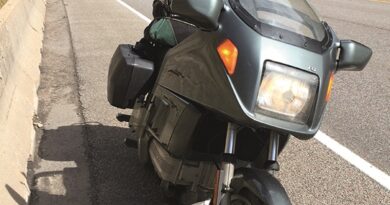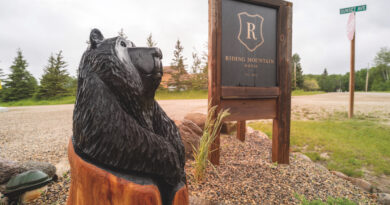A trip back in time to the 2013 Fireflight Rendezvous
It was the first real trip I’d taken on my 1973 R75/5. I’d become fascinated with classic motorcycles over the years, gazing fondly at the beautiful old bikes in Motorcycle Classics and similar publications. I was especially intrigued with older BMWs; most sources suggested they were more reliable than some of their British cousins, there seemed to be a large aftermarket still supporting them, and BMW even carries some parts for classic and vintage models. My head was swimming with terms like airhead, Slash 2, Earles forks, R 90 S and the like. I had visions of riding off on a tour on a stately older BMW—a bike that I certainly couldn’t afford when both they and I were younger!
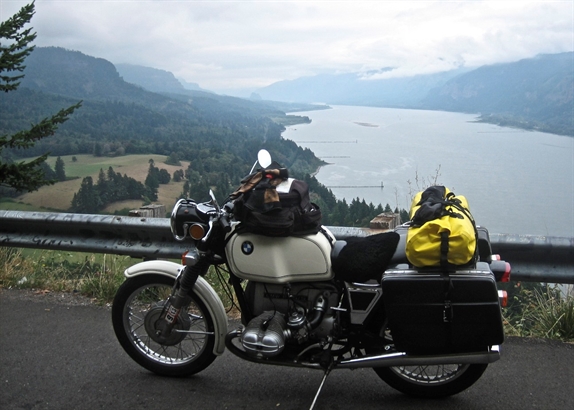 The dream got closer to reality when I happened upon a gorgeous white R 75/5 on eBay. I showed the photos to my long-suffering wife; much to my surprise her reaction was That’s a pretty bike . . . We were living in Virginia at the time so we drove north to the Philadelphia area in July 2011 and came home with a 40-year-old motorcycle. As we later read, What could go wrong? Billed as ready to ride across the country complete with a larger Slash 7 fuel tank, it wasn’t—of course. A new starter, replacement electronic ignition, carburetor rebuild, new pushrod tube seals, some racks and luggage and the owner’s retirement and subsequent cross-country move, and finally, we’re ready!
The dream got closer to reality when I happened upon a gorgeous white R 75/5 on eBay. I showed the photos to my long-suffering wife; much to my surprise her reaction was That’s a pretty bike . . . We were living in Virginia at the time so we drove north to the Philadelphia area in July 2011 and came home with a 40-year-old motorcycle. As we later read, What could go wrong? Billed as ready to ride across the country complete with a larger Slash 7 fuel tank, it wasn’t—of course. A new starter, replacement electronic ignition, carburetor rebuild, new pushrod tube seals, some racks and luggage and the owner’s retirement and subsequent cross-country move, and finally, we’re ready!
I’d ridden my R1150GS back to my hometown in eastern Oregon earlier in the summer (see BMW ON Nov 2013, ADV Ride Report). This time the destination was the tiny town of Maupin, located on the lower Deschutes River 40 miles south of The Dalles Oregon. Held September 5-8 this year, the Fireflight Rendezvous is a yearly gathering of BMW airheads from all over the Pacific Northwest. Originally taking place in the forested high country along the east side of the Oregon Cascades, the Rendezvous had moved to Maupin under the threat of forest fires one year. This move proved serendipitous—the event’s been held at the Maupin City Park ever since.
 Maupin may be the ideal setting for a gathering of old motorcycles. Straddling the river with deep basalt canyons on either side, Maupin began as a river crossing in the 19th century and grew as the railroad extended down the canyon. With a current population of under 500, it appears the town’s main claim to fame is as a fishing and river running center in the summer months. While there’s only one gas station and a few restaurants, the local grocery store has a prime selection of malted barley and fermented grape products—all within easy walking distance to the park’s campsites.
Maupin may be the ideal setting for a gathering of old motorcycles. Straddling the river with deep basalt canyons on either side, Maupin began as a river crossing in the 19th century and grew as the railroad extended down the canyon. With a current population of under 500, it appears the town’s main claim to fame is as a fishing and river running center in the summer months. While there’s only one gas station and a few restaurants, the local grocery store has a prime selection of malted barley and fermented grape products—all within easy walking distance to the park’s campsites.
Leaving my home in western Washington on Thursday afternoon, my route took me south on I5, then east on Washington 14 through the Columbia River Gorge and into the high wheat country of central Oregon. The R75/5 is not a fast motorcycle; while heralded as one of the finest touring bikes in the world when it was new, motorcycle technology and interstate highway speeds have long overtaken the old bike. Its four-speed transmission coupled with my reluctance to flog a 40-year-old machine dictates a slower pace. The bike seems to be in its groove in the 55-65 mph range, so there it stays!
 An interstate is usually just that—a way to get somewhere. But the ride along the Columbia River Gorge never gets old; the transition from the western slope Douglas Fir forests and moss-covered rocks, through eastern-slope pine groves, to the open sage lands of the dry side makes a marvelous riding experience. The twisty curves and numerous tunnels along highway 14 are an additional highlight as much of the heavy truck traffic stays on Interstate 84 on the Oregon side of the Gorge, and the slower pace of the Washington route suite the old BMW just fine. Through Washougal past the Pendleton Woolen Mills, Beacon Rock, the Bonneville Dam, through the tiny towns of White River, Carson, Bingen, fruit stands and espresso shacks, past the Bridge of the Gods and on to the east side, the Slash 5 motored on like the trooper it is.
An interstate is usually just that—a way to get somewhere. But the ride along the Columbia River Gorge never gets old; the transition from the western slope Douglas Fir forests and moss-covered rocks, through eastern-slope pine groves, to the open sage lands of the dry side makes a marvelous riding experience. The twisty curves and numerous tunnels along highway 14 are an additional highlight as much of the heavy truck traffic stays on Interstate 84 on the Oregon side of the Gorge, and the slower pace of the Washington route suite the old BMW just fine. Through Washougal past the Pendleton Woolen Mills, Beacon Rock, the Bonneville Dam, through the tiny towns of White River, Carson, Bingen, fruit stands and espresso shacks, past the Bridge of the Gods and on to the east side, the Slash 5 motored on like the trooper it is.
Even in early September, even the dry side sometimes isn’t. While the western slope of the Coast Range and the Cascades catches most of the moisture, strong weather systems do bring occasional rain to eastern Oregon. I was reminded of this pattern climbing out of the Gorge on US 197 when the sky to the south turned an ominous shade of black! Yes, I discovered the old Aerostich Darian is still waterproof, and their Triple Digit rain mitts and VeeWipe squeegees still work too! Riding through a short 15 miles of almost torrential downpour, the old bike soldiered onward. The rain eased off just north of Maupin where the Oregon Air Marshal Garry Newby and several other airheads were already camped at the Park. The rain pause allowed me to get my tent up without even getting wet. While it rained later that night, the weather got progressively better throughout the rest of the weekend with the later arrivals at the Rendezvous staying dry the entire weekend.
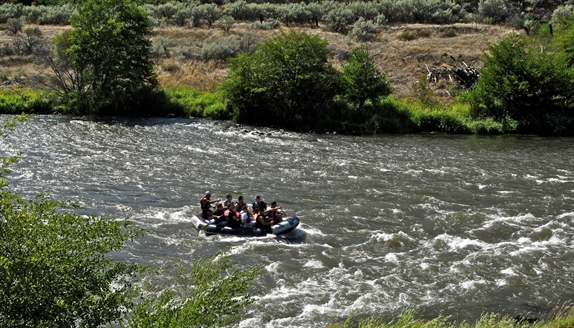 The Fireflight is not an organized rally. Billed as a rendezvous, it’s a gathering of like-minded motorcyclists in a gorgeous small-town location to meet, chat, occasionally wrench on bikes, engage in evening barley therapy and ride when—and where—they wish. As a laid-back event, the goal is simply to have a good time with good friends. And we did—by the end of the weekend, I counted over 40 bikes along the curb in the city park. Mostly BMW airheads of course, but a smattering of oilheads and the occasional off-brand was also welcomed.
The Fireflight is not an organized rally. Billed as a rendezvous, it’s a gathering of like-minded motorcyclists in a gorgeous small-town location to meet, chat, occasionally wrench on bikes, engage in evening barley therapy and ride when—and where—they wish. As a laid-back event, the goal is simply to have a good time with good friends. And we did—by the end of the weekend, I counted over 40 bikes along the curb in the city park. Mostly BMW airheads of course, but a smattering of oilheads and the occasional off-brand was also welcomed.
Friday and Saturday were chances for me to ride my old airhead around parts of Oregon that I’d avoided when I lived in the state during my misspent youth. Friday proved to be the laziest day with storm clouds dissipating and the sun making it’s appearance. I made a short loop of it, riding east up curvy Bakeoven Road to the not-so-thriving town of Shaniko, north to Grass Valley, and back west down Sherars Bridge Highway to Tygh Valley. Both roads out and back into the Deschutes Canyon are well graded, fun, twisty roads—but the previous thunderstorms had the unfortunate effect of washing fresh mud and gravel over the best corners! Many excellent reasons to never out-ride your sightlines were demonstrated on these roads today!
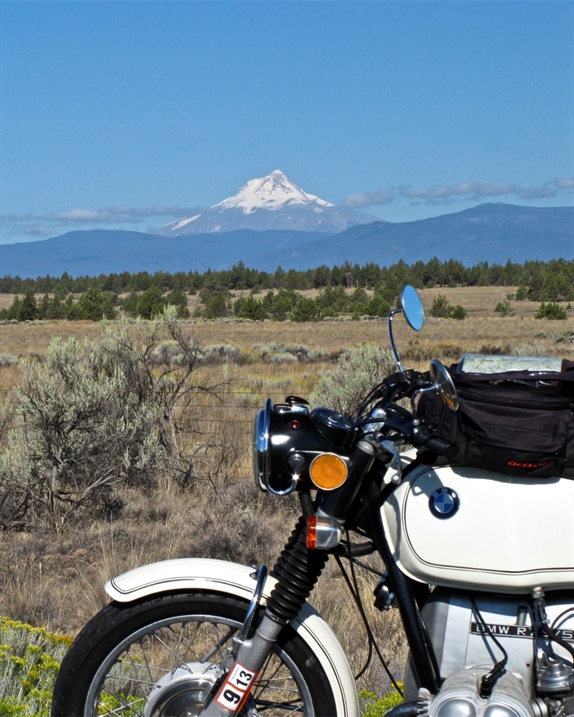 Shaniko was a once lively little town. During its heyday in the early 1900s, it was known as the “Wool Capital of the World” with rail service north to the Columbia River, a population at its height of almost 500 people and was the center of a huge area of wool, cattle and wheat production. The 2010 census listed 36 people living in Shaniko, which has recently become the center of a water rights dispute between a wealthy investor and some of the remaining townspeople. Many of the original and restored buildings are shuttered, and there’s no fuel available in this now rather sad, tiny town on the high plateau.
Shaniko was a once lively little town. During its heyday in the early 1900s, it was known as the “Wool Capital of the World” with rail service north to the Columbia River, a population at its height of almost 500 people and was the center of a huge area of wool, cattle and wheat production. The 2010 census listed 36 people living in Shaniko, which has recently become the center of a water rights dispute between a wealthy investor and some of the remaining townspeople. Many of the original and restored buildings are shuttered, and there’s no fuel available in this now rather sad, tiny town on the high plateau.
Saturday’s ride was a loop west through the Warm Springs Reservation. Open roads and clear blue skies allowed fantastic views of the Cascade Range to the west. Mt. Hood, Mt. Jefferson, Three Fingered Jack, and to the southwest, Mt Washington and the Three Sisters could be seen along this route. Wapinita Road through the reservation drops down from the plateau country to the Warm Springs River through broad expanses of sagebrush as well as groves of Juniper and Ponderosa Pine forest. The modern lodge and golf course at Kah-nee-tah is a stark contrast to the surrounding forest and small ranches. I rode through without stopping at the lodge.
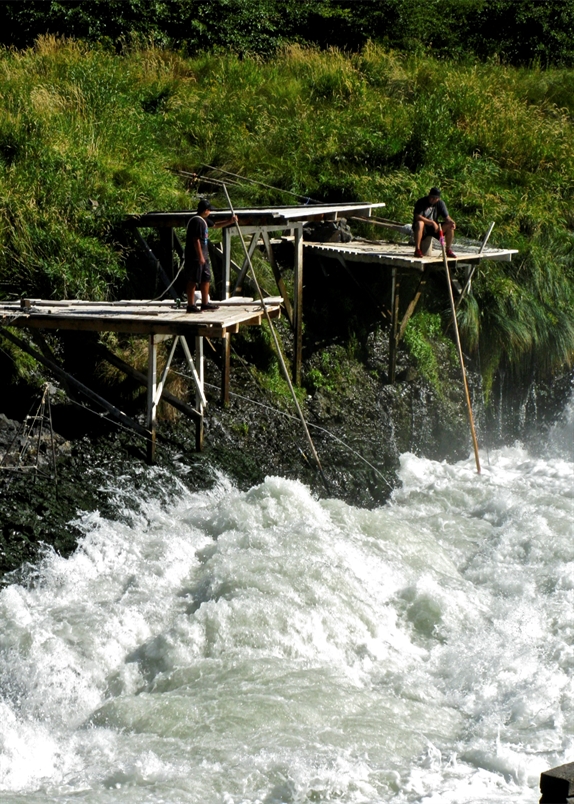 I paused instead at the Warm Springs Museum in the town of the same name along US 26—a highly recommended stop. Displaying the Native American perspective it provides insights into the culture and lifestyle of this beautiful area’s inhabitants both prior to and resulting from European influence.
I paused instead at the Warm Springs Museum in the town of the same name along US 26—a highly recommended stop. Displaying the Native American perspective it provides insights into the culture and lifestyle of this beautiful area’s inhabitants both prior to and resulting from European influence.
Among many other interesting subjects, the Museum discusses native pictographs and petroglyphs; rock art left by a variety of tribal artists over millennia with examples scattered across the West. I’d heard a few examples were visible near Sherars Falls on the Deschutes River just a few miles north of Maupin. Arriving back at camp early on Saturday I ventured along the River Access road toward the Bridge, stopping to watch river rafters during the warm and sunny afternoon. Some of my previously mentioned misspent youth put me on several wild Northwest rivers for Northwest Outward Bound, and I enjoyed watching both the guided and individual boats negotiate the rapids—and I suspect one of the guides spun his raft on purpose to bury the upstream gunwale and put a couple of his passengers in the water! It’s all part of the fun.
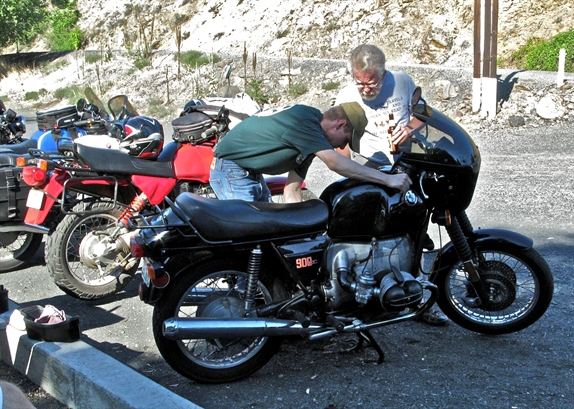 Parking the Slash 5 near Sherars Bridge, I walked along the highway. The Warm Springs tribe has recently been given traditional fishing rights along this stretch of the river and a number of the platforms above the roaring water were in use today. I saw one fisherman walking back to his truck with a fine salmon, over two feet long. Turning to the outcroppings next to the road I finally spotted several pictographs carved into the rock. Even though there’s evidence of more recent vandalism, several carvings were easy to spot and were a visual reminder of this area’s historical significance to the local tribes.
Parking the Slash 5 near Sherars Bridge, I walked along the highway. The Warm Springs tribe has recently been given traditional fishing rights along this stretch of the river and a number of the platforms above the roaring water were in use today. I saw one fisherman walking back to his truck with a fine salmon, over two feet long. Turning to the outcroppings next to the road I finally spotted several pictographs carved into the rock. Even though there’s evidence of more recent vandalism, several carvings were easy to spot and were a visual reminder of this area’s historical significance to the local tribes.
Sunday’s ride home was a fantastic ride through the best scenery that the Pacific Northwest offers. Up early, packed quickly and I was soon retracing my northerly path to The Dalles and across the mighty Columbia to Highway 14 again. With the mountains shining in the west and the river sparkling brightly in the morning sun, the old Slash 5 seemed to know it was heading towards home and purred sweetly through the sleepy Sunday towns along the way.
 Rather than just repeating Thursday’s ride, I turned north at Carson along the Wind River Road, navigating toward Forest Road 25 and the east side of Mt. St. Helens. The was the same basic route I took in June on the GS, except this time I wanted to ride FS99 to the Windy Ridge viewpoint on the eastern flank of the mountain. Where FS25, the main north-south Forest Service road, is rough and spectacularly frost-heaved, FS99 is much newer with mostly smooth pavement, sweeping curves, magnificent vistas, with tourists creeping skyward while marveling at the scenery.
Rather than just repeating Thursday’s ride, I turned north at Carson along the Wind River Road, navigating toward Forest Road 25 and the east side of Mt. St. Helens. The was the same basic route I took in June on the GS, except this time I wanted to ride FS99 to the Windy Ridge viewpoint on the eastern flank of the mountain. Where FS25, the main north-south Forest Service road, is rough and spectacularly frost-heaved, FS99 is much newer with mostly smooth pavement, sweeping curves, magnificent vistas, with tourists creeping skyward while marveling at the scenery.
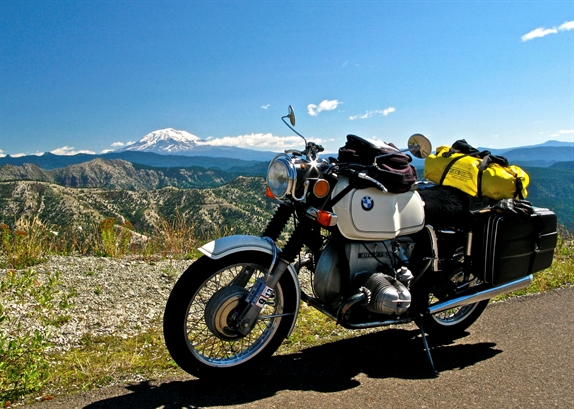 I’d climbed Mt. St. Helens several times while in college, years before the 1980 volcanic eruption that killed 57 people and completely changed the look of the mountain and much of the surrounding terrain. So this was the first time I saw the new Spirit Lake amidst a vast array of gray volcanic debris, skeletal trees, emerging green undergrowth and new forest; it was so much different than the idyllic mountain lake surrounded by forest that I remembered. It was sobering to think of the devastation wrought by those natural volcanic events and reflect on the fact that the entire Cascade range has been formed in much the same way over the millennia—and that volcanic change will continue unabated in the future with equally dramatic effects on whoever lives in the region.
I’d climbed Mt. St. Helens several times while in college, years before the 1980 volcanic eruption that killed 57 people and completely changed the look of the mountain and much of the surrounding terrain. So this was the first time I saw the new Spirit Lake amidst a vast array of gray volcanic debris, skeletal trees, emerging green undergrowth and new forest; it was so much different than the idyllic mountain lake surrounded by forest that I remembered. It was sobering to think of the devastation wrought by those natural volcanic events and reflect on the fact that the entire Cascade range has been formed in much the same way over the millennia—and that volcanic change will continue unabated in the future with equally dramatic effects on whoever lives in the region.
At least the spectacularly good weather allowed magnificent views of Mt. Adams as well as Mt. St. Helens. From desert plateaus through rocky canyons and river gorges to fertile farmland, verdant forests and snow-covered volcanic peaks, the Pacific Northwest has it all. One of the best ways to see the region is on an old BMW – slowly.

